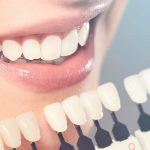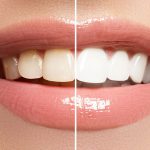Laminate Veneer (Laminated Teeth)
Laminate veneers are primarily used to correct discoloration and, to a certain extent, to improve tooth shape.
The main areas of application can be summarized as follows:
-
In advanced discoloration cases (due to antibiotics, fluoride, etc.) where bleaching methods are ineffective, and in hereditary structural and color disorders
-
For closing gaps between teeth (diastema closure)
-
In the restoration of broken or worn teeth
-
For correcting discolored or structurally compromised old fillings
-
For correcting crowded or misaligned teeth (as a cosmetic alternative to orthodontic treatment)
-
Treatment of spaced teeth (diastema) with laminates
Advantages of Laminate Veneers
In cases where you cannot smile confidently due to decay, wear, fractures, or structural anomalies, this method can provide your teeth with a naturally beautiful appearance. While in the past, full crowns or fillings were the only solutions for such conditions, today laminate treatment offers a new alternative.
With this application:
-
A healthy and natural appearance is achieved with minimal intervention in a very short time.
-
It is sufficient to prepare a small groove on the tooth surface, about the width of a fingernail (which may not even be necessary in all cases).
-
They are made from durable materials that retain their color and strength.
-
It is only possible with laminate veneers to achieve desired aesthetic properties without altering the natural structure of your teeth. Either no changes are made to the tooth surface, or only minimal adjustments are needed to ensure an ideal result. In fact, the amount removed from the tooth is limited to 0.3–0.7 mm, meaning no need for cutting (reducing) the tooth.
-
The laboratory stage of treatment takes only 3–4 days. However, the process of adapting the lips to the new smile design may take 3–4 weeks. During this adaptation period, lip exercises and reading aloud are recommended. After this period, you can smile comfortably with teeth that fully integrate with your face and appear completely natural.
-
A model of your existing teeth can be created and used for design before any intervention, allowing you to preview the planned changes.
-
The porcelain surface is extremely smooth, minimizing staining from smoking and similar causes, and reducing tartar formation.
-
It does not discolor due to external factors such as coffee, tea, or cigarettes.
-
As a material, it is quite fragile. However, when fully bonded to enamel, its resistance to tensile and compressive forces significantly increases. For example, it is not possible to remove an adhered veneer as a whole; it can only be removed by grinding it down with diamond burs.
-
It is highly resistant to wear.
Disadvantages of Laminate Veneers
Compared to other restorations, laminate veneers have advantages in terms of health. However, they are relatively more expensive than other options.
It is a sensitive technique that requires excellent clinical and laboratory work. The dentist and the dental technician must have both technical knowledge and artistic skill in this field.
Steps of Laminate Treatment
First, the tooth is prepared, and surface residues are cleaned. Then, impressions are taken to obtain a precise copy of the tooth. A thin porcelain layer is then prepared to be bonded to the tooth. Finally, as with adhesive systems (bonding), the laminate is fused to the existing tooth surface using a resin (adhesive agent).
People of all age groups can benefit from laminate treatment. However, it is not suitable in cases of jaw disorders, habits such as nail biting or pen chewing, or in situations with severe gum damage. The dentist is the best person to decide on this.
With proper oral care, laminates can be used for many years without problems. They are made from porcelain with superior properties compared to other adhesive systems (like bonding). They are more resistant to staining and wear. To prolong their lifespan, good oral hygiene must be maintained. It is also necessary to avoid biting hard foods and eliminate habits like nail biting.


